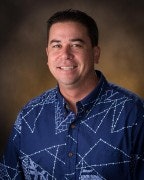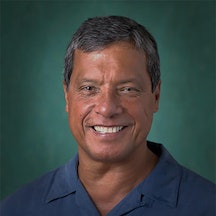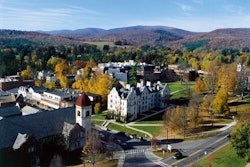At the University of Hawai’i at Mānoa (UH Mānoa), Native Hawaiian students make up roughly 15% of the undergraduate student population. The school is one of only 21 institutions that qualifies for federally designated funding as an Alaskan Native, Native Hawaiian serving institution.
 Dr. Willy Kauai, director of Native Hawaiian student services at UH Mānoa.
Dr. Willy Kauai, director of Native Hawaiian student services at UH Mānoa.
“There’s a different kind of culture and opportunities that exist now from pre-K through grade 12 that has created the conditions for Native Hawaiians to now access higher education in higher numbers than we’ve ever seen historically,” said Kauai. “That’s very much a result of community awareness, but also faculty and student advocacy to say, ‘Hey, Native Hawaiians are underrepresented across the higher education playing field.’”
While Native Hawaiians are underrepresented in higher education, they are overrepresented in poverty, houselessness, workforce and health disparities, said Kauai. According to a 2020 report from Asian and Pacific Islander Americans (APIA) Scholars, an organization working to support Asian American and Pacific Islander (AAPI) student success, 50% of Native Hawaiian students leave college without receiving a degree or certificate. Fifty-three percent of Native Hawaiians have not enrolled in any kind of postsecondary education.
The Native Hawaiian diaspora has grown, partially in response to the growing social and economic challenges in the archipelago. More Native Hawaiians now live outside of Hawaii than on the islands themselves, the vast majority located on the U.S. mainland. Without full disaggregation of student population data, the stories, history, and culture of Native Hawaiian students, faculty, and staff can often go unseen in higher education.
“The way populations have identified here has changed over the years. I can remember when we were lumped into Asian, Pacific Islander,” said Dr. Jonathan Kay Kamakawiwoʻole Osorio, dean of Hawaiʻinuiākea School of Hawaiian Knowledge at UH Mānoa. Often, Native Hawaiians are grouped into the catch-all racial category: other.
“It seems as though it changes back and forth depending on which agency it is that’s doing the collection of the data,” said Osorio.
UH Mānoa allows students to identify in many different ways, offering nuance and visibility to a student’s experience. That expansive data disaggregation is deliberate and can be attributed to efforts led by the Native Hawaiian community, faculty, staff, and students on campus, said Nikki Chun, vice provost for enrollment management at UH Mānoa.
 Dr. Nikki Chun, vice provost for enrollment management at UH Mānoa.
Dr. Nikki Chun, vice provost for enrollment management at UH Mānoa.
Osorio and Kauai braid Hawaiian ancestral teaching, culture, and perspectives into their courses and share that curriculum with other departments, including English, history, political science, and more. Just under 8% of UH Mānoa faculty identify as Native Hawaiian, the largest representation of Native Hawaiian faculty ever seen at the campus.
“There are more Native Hawaiian faculty engaging in research on this campus than anywhere else in the world. They’ve become one of our greatest modes of recruitment and retention,” said Kauai. “The more we grow our Native Hawaiian faculty, the other numbers will follow.”
Before U.S. occupation, the Hawai'ian Kingdom was dedicated to the education and wellbeing of its citizens. In 1893, the Native Hawaiian population was almost entirely literate and had access universal healthcare.
“The University of Hawai'i Mānoa opened its doors in 1907, a little less than 10 years after Hawai'i is occupied," said Kauai. "But it’s within [the next] 100 years you see Native Hawaiians experience dispossession and barriers in higher education.”
Broader U.S. recognition of Native Hawaiian accomplishments, culture, and representation received a potential boost in October, when Secretary of the Interior Deb Haaland announced that the department would require formal consultations with the Native Hawaiian community. The new policy would “help support Native Hawaiian sovereignty and self-determination,” Haaland said. But whether a U.S. declaration of Hawaiian sovereignty would have heft beyond mere discourse is hard to tell, Osorio said.
 Dr. Jonathan Kay Kamakawiwoʻole Osorio, dean of Hawaiʻinuiākea School of Hawaiian Knowledge at UH Mānoa.
Dr. Jonathan Kay Kamakawiwoʻole Osorio, dean of Hawaiʻinuiākea School of Hawaiian Knowledge at UH Mānoa.
While the issue of Hawaiian sovereignty plays out across the ocean, Osorio said he and his fellow Native Hawaiian staff will continue to build UH Mānoa into a Hawaiian institution by bringing more Native Hawaiian students, faculty and staff back to their homeland and their history.
Liann Herder can be reached at [email protected]
















